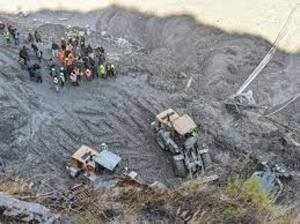 Agencies
AgenciesWhile the study stops short of linking the disaster directly to climate change, it says that the increasing frequency of high-mountain slope instabilities can likely be related to ‘observed atmospheric warming and corresponding long-term changes in cryospheric conditions (glaciers, permafrost)’.
It also warns on the hydropower projects coming up in the hill state.
‘The disaster tragically revealed the risks associated with the rapid expansion of hydropower infrastructure into increasingly unstable territory’, says the study titled - A massive rock and ice avalanche caused the 2021 disaster at Chamoli, Indian Himalayas.
The study was done by researchers from prestigious institutes in India and abroad through an international collaboration.
It adds that ‘Human activities that intersect with the mountain cryosphere can increase risk and are common in Himalayan valleys where hydropower development is proliferating due to growing energy demands, the need for economic development, and efforts to transition into a low-carbon society ‘.
CLIMATE LINK
Expanding on possible linkage with climate change, the study points out that Air and surface temperatures have been increasing across the Himalayan region, with greater rates of warming during the second half of the 20th Century and at higher elevations.
‘Most glaciers in the Himalaya are shrinking and mass loss rates are accelerating across the region . Glacier shrinkage uncovers and destabilizes mountain flanks and strongly alters the hydrological and thermal regimes of the underlying rock’, it says.
It says that analysis suggests ‘regional climate and related cryospheric change could have interacted in a complex way with the geologic and topographic setting to produce this massive slope failure’.
It also surmised that increasing ground temperatures at the failure site of the Chamoli avalanche could have resulted in reduced strength of the frozen rock mass by altering the rock hydrology and the mechanical properties of discontinuities and the failed rock mass.
“Multiple factors beyond those listed above contributed to the Chamoli rock and ice avalanche, including the geologic structure and steep topography, possible long-term thermal disturbances in permafrost bedrock induced by atmospheric warming, stress changes due to the decline and collapse of adjacent and overlying glaciers, and enhanced melt water infiltration during warm periods”, says the study.
The researchers state that the Chamoli event also raises ‘important questions about clean energy development, climate change adaptation, disaster governance, conservation, environmental justice, and sustainable development in the Himalaya and other high-mountain environments’ and stresses the importance of a better understanding of the cause and impact of mountain hazards, leading to disasters.
SCALE OF DISASTER
The rock and ice avalanche has been termed a ‘very large event with an extraordinarily high fall height that resulted in a disaster due to its extreme mobility and the presence of downstream infrastructure’.
The high loss of human life and infrastructure damage was, however, due to the ‘debris flow’, and not the initial rock and ice avalanche, it says.
The ~3700 m vertical drop to the Tapovan Hydro power plant is surpassed clearly by only two known events in the historic record, namely the 1962 and 1970 Huascaran avalanches while its mobility is exceeded only by a few recent glacier detachments, the study adds.
Nearly all of the 204 people either killed or missing in the disaster were workers at the Rishiganga (13.2 MW) and Tapovan (520 MW) project sites . Direct economic losses from damage to the two hydropower structures alone are estimated over 223 million USD.
Download The Economic Times News App to get Daily Market Updates & Live Business News.
Subscribe to The Economic Times Prime and read the ET ePaper online.
Download The Economic Times News App to get Daily Market Updates & Live Business News.
Subscribe to The Economic Times Prime and read the ET ePaper online.









 Get Unlimited Access to The Economic Times
Get Unlimited Access to The Economic Times
